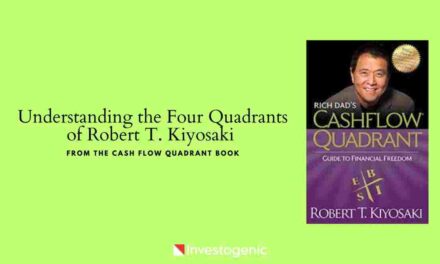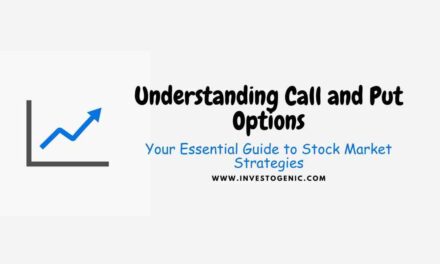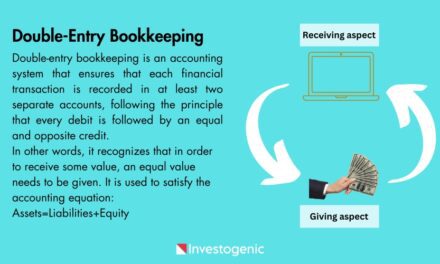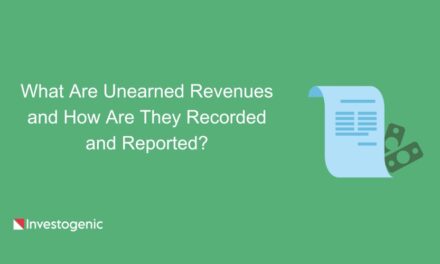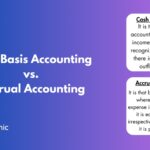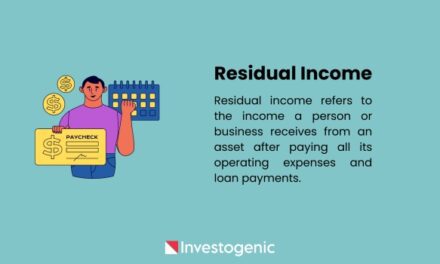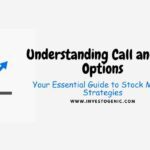
Understanding Call and Put Options: Your Essential Guide to Stock Market Strategies

The world of trading and investing in the stock market is complex and dynamic, often involving a wide variety of financial instruments and approaches. Call options and put options are two such instruments that are essential in this field. If you want to deepen your understanding of the stock market or look for new investment opportunities, it is important to understand the fundamentals of these options. In contrast to put options, which give you the right to sell an asset at a fixed price and can help you benefit in declining markets, call options provide you the right to acquire the underlying asset at a predetermined price.
In this blog post, we will delve into the intricacies of call-and-put options and learn their essential elements, strategies, and how they can enable you to confidently navigate the stock market. You can combine these options in many ways, creating strategies such as “Vertical Spread”, “Iron Condor” and “Butterfly”. Understanding these possibilities is an important first step for every investor to improve their financial knowledge and reach their investment objectives.
KEY TAKEAWAYS
- Calls become more valuable when the underlying stock increases, making them bullish.
- It puts an increase in value when the underlying stock declines and is thus bearish.
- When the underlying stock remains unchanged, the value of calls and puts both declines.
- Maximum profit in calls is infinite; maximum profit inputs are defined.
- Calls are in-the-money when the strike price is below the stock price.
- Puts are profitable if the strike price is higher than the stock price.
What are the CE or call options?
CE refers to call options, but it literally means Calls European. Call options, or CEs, are financial derivatives that give the holder (buyer) the right, but not the obligation, to buy a specific quantity of an underlying asset, such as a stock, at a predetermined price (known as the strike price). A specified period of time (until the expiration date).
Call options are typically used when an investor anticipates that the price of the underlying asset will rise. If the asset’s price does indeed increase above the strike price, the call option holder can profit by exercising the option or selling it for a higher premium.
Key Components of a Call Option
- Underlying Asset: This is the asset (e.g., a stock, index, commodity) that the option derives its value from.
- Strike Price: The strike price, also known as the exercise price, is the price at which the holder has the right to buy the underlying asset if they choose to exercise the option.
- Expiration Date: Call options have a specific expiration date, which is the last day on which the option can be exercised. After this date, the option becomes worthless.
- Premium: The premium is the price the buyer of the call option pays to the seller (writer) of the option. It represents the cost of acquiring the right to potentially buy the underlying asset at the strike price. The premium is determined by various factors, including the current market price of the underlying asset, the strike price, the time until expiration, and market volatility.
How to Profit from a Call Option or CE
A trader must anticipate a price increase for the underlying asset to profit from call options. By acquiring a call option at a given strike price, traders get the right, but not the obligation, to purchase the underlying asset at that price within a specified period. Let the market price of the asset increase above the strike price. In that case, traders can sell the option for a profit or exercise the opportunity to acquire the purchase at the lower strike price and sell it at a higher market price.
Example of Call Options
Let’s go through an example of how call options work in the stock market:
SCENARIO:
Suppose you are an investor interested in trading call options on Company ABC, a fictional technology company whose stock is currently trading at $50 per share. You have a bullish outlook on Company ABC and believe its stock price will increase in the near future.
Step 1: Choosing the Call Option Contract
You decide to purchase a call option contract with the following details:
- Underlying Stock: Company ABC
- Strike Price: $55 per share
- Expiration Date: 3 months from today
- Premium: $3 per share
This means you are buying a call option that gives you the right (but not the obligation) to buy Company ABC’s stock at $55 per share within the next three months. You pay a premium of $3 per share for this option.
Step 2: Market Movement
Now, there are a few possible scenarios based on how the stock price of Company ABC performs before the option expiration date:
- Stock Price Increases: If, before the expiration date, the stock price of Company ABC rises above the strike price of $55 per share (let’s say it goes up to $60 per share), your call option becomes profitable.
- You can exercise your call option and buy Company ABC’s stock at the lower strike price of $55 per share (even though the market price is $60 per share).
- Your profit per share would be the difference between the market price and the strike price minus the premium paid:
- Profit per Share = ($60 – $55) – $3 = $2 per share
- If you hold multiple call options, your total profit would be calculated by multiplying the profit per share by the number of contracts you own.
- Stock Price Stays the Same or Decreases: If the stock price of Company ABC remains at or below $55 per share, your call option will expire worthless.
- In this case, you would lose the premium you paid for the call option, as you have no incentive to buy the stock at the higher strike price when you can buy it for a lower market price.
Step 3: Outcome Analysis
In this example, you used a call option to profit from your bullish outlook on Company ABC. If the stock price increased as you expected, you could exercise the call option to buy the stock at a lower strike price and make a profit. However, if the stock price didn’t increase, you would incur a loss equal to the premium paid for the call option.
Uses of Call Options
Call options can be used for various purposes, including:
- Speculation: Traders may buy call options when they believe the underlying asset price will rise. If the price indeed rises above the strike price, they can profit by exercising the option or selling it at a higher premium.
- Hedging: Investors may use call options to hedge their existing positions in the underlying asset. For example, if someone holds a significant number of shares in a stock and wants to protect against a potential price decline, they can buy call options as a form of insurance.
- Income Generation: Some investors engage in covered call writing, owning the underlying asset and selling call options against it. This strategy allows them to collect premiums from selling calls while potentially limiting their upside profit potential.
Risk in Call Options
Call options offer profit potential but also involve risk. While purchasing a call option involves limited financial risk, selling it can result in unlimited loss if the underlying asset price increases significantly. Understanding these risks is crucial for trading or investing. Here are the primary risks associated with call options:
- Limited Time Horizon: Call options have expiration dates. When an option expires, it loses all of its value plus the premium you paid to purchase it. Due to the short expiration period, you have to accurately predict both the timing and direction of the price movement of the underlying asset to profit from the option.
- Loss of Premium: When you purchase a call option, you pay a premium for the right to potentially buy the underlying asset at the strike price. If the asset’s price doesn’t rise above the strike price by expiration, you lose the entire premium paid. This represents a potential loss for call buyers.
- Market Risk: Call options are sensitive to changes in the price of the underlying asset. If the asset’s price moves against your call position, you can incur losses. The magnitude of these losses can be significant, especially if the asset’s price moves far below the strike price.
- Time Decay (Theta): Options experience time decay, meaning their value erodes as time passes, all else being equal. This erosion accelerates as the option approaches its expiration date. If the underlying asset’s price doesn’t move in the desired direction quickly, time decay can erode the option’s value.
- Volatility Risk: High volatility can work for or against call option buyers. While it can lead to larger potential gains if the asset’s price moves in the desired direction, it can also increase the cost of options (higher premiums) and lead to more substantial losses if the asset’s price moves against the call position.
- Lack of Ownership Rights: Call option holders have the right to buy the underlying asset at the strike price but are not entitled to dividends, voting rights, or other benefits associated with owning the actual shares of the asset. This can be a disadvantage in certain situations.
- Assignment Risk: If you hold a call option until expiration and it is in-the-money (the underlying asset’s price is above the strike price), you may be assigned the obligation to buy the underlying asset. While this is the desired outcome for many call buyers, it can lead to unexpected capital requirements and transaction costs.
How to manage the risks associated with call options
To manage the risks associated with call options, investors often employ various strategies, including setting stop-loss orders, diversifying their options portfolio, and using risk management techniques.
Managing the risks associated with call options is crucial for successful option trading. Here are some strategies and techniques to help you mitigate and manage those risks:
- Set Stop-Loss Orders: Consider setting stop-loss orders to limit potential losses. A stop-loss order specifies a price at which your call option position will be automatically sold if the market moves against you. It helps prevent significant losses by ensuring you exit a losing trade at a predetermined level.
- Use Position Sizing: Determine the size of your call option positions based on your risk tolerance and overall portfolio. Avoid putting a significant portion of your capital into a single-call option trade. Position sizing helps spread risk across different assets or trades.
- Diversify Your Options Portfolio: Don’t concentrate all your call option trades in a single stock or sector. Diversifying your options portfolio across various underlying assets can help reduce the impact of poor performance in one area.
- Select an Appropriate Strike Price and Expiration Date: Carefully choose the strike price and expiration date for your call options. A strike price too close to the current market price may result in higher premiums and less room for price movement. An expiration date too short may increase the risk of time decay working against you. Align these choices with your trading strategy and risk tolerance.
- Practice Risk-Defined Strategies: Consider using risk-defined strategies, such as vertical spreads or iron condors, which involve both buying and selling call options to limit potential losses. These strategies cap both potential gains and losses, providing a known risk-reward profile.
- Monitor Your Positions: Keep a close eye on your call option positions and the underlying assets. Be prepared to adjust or close positions based on changing market conditions or when your initial trade thesis no longer holds. Active management can help limit losses.
- Set Realistic Profit and Loss Targets: Define your profit and loss targets before entering a trade. This helps you maintain discipline and avoid chasing unrealistic gains. If a trade reaches your profit target, consider taking profits and not being overly greedy.
- Understand Implied Volatility: Be aware of implied volatility levels when trading options. High implied volatility can lead to higher option premiums, which can impact the cost of your call options. Consider trading options when implied volatility is reasonable relative to your strategy.
What are the PE or put options?
PE refers to put options, but it means put European. Put options or PEs, are financial derivatives that give the holder (the buyer) the right, but not the obligation, to sell a specific quantity of an underlying asset, such as a stock, at a predetermined price (known as the strike price) within a specified period (until the expiration date).
Put options are often used when an investor expects the price of the underlying asset to fall. If the asset’s price drops below the strike price, the put option holder can profit by exercising the option or selling it for a higher premium.
Key Components of a Put Option
- Underlying asset: This is the asset (for example, a stock, index, or commodity) from which the option derives its value.
- Strike Price: The strike price, also known as the exercise price, is the price at which the holder has the right to sell the underlying asset if they choose to exercise the option.
- Expiry Date: A put option has a specific expiration date, which is the last day on which the option can be exercised. After this date, the option becomes worthless.
- Premium: The premium is the price that the buyer of a put option pays to the seller (writer) of the option. It represents the cost of obtaining the right to potentially sell the underlying asset at the strike price. The premium is determined by various factors, including the current market price of the underlying asset, the strike price, the time until expiration, and market volatility.
How to Profit from a Put Option or PE
Put option can be advantageous when traders anticipate a price decline for the underlying asset. By acquiring a Put option at a specified strike price, traders obtain the right, but not the obligation, to sell the underlying asset at the fixed price within a specified time frame. If the asset’s market price falls below the strike price, traders can sell the option for a profit or exercise the option to avoid losses by selling the asset at a higher strike price.
Example of Put Options
Let’s go through an example of how put options work in the stock market:
SCENARIO:
Suppose you are an investor interested in trading put options on Company XYZ, a fictional manufacturing company whose stock is currently trading at $100 per share. You have a bearish outlook on Company XYZ and believe its stock price will decrease in the near future.
Step 1: Choosing the Put Option Contract
You decide to purchase a put option contract with the following details:
- Underlying Stock: Company XYZ
- Strike Price: $95 per share
- Expiration Date: 3 months from today
- Premium: $4 per share
This means you are buying a put option that gives you the right (but not the obligation) to sell Company XYZ’s stock at $95 per share within the next three months. You pay a premium of $4 per share for this option.
Step 2: Market Movement
Now, there are a few possible scenarios based on how the stock price of Company XYZ performs before the option expiration date:
- Stock Price Decreases: If, before the expiration date, the stock price of Company XYZ falls below the strike price of $95 per share (let’s say it goes down to $90 per share), your put option becomes profitable.
- You can exercise your put option and sell Company XYZ’s stock at the higher strike price of $95 per share (even though the market price is only $90 per share).
- Your profit per share would be the difference between the strike price and the market price minus the premium paid:
- Profit per Share = ($95 – $90) – $4 = $1 per share
- If you hold multiple put options, your total profit would be calculated by multiplying the profit per share by the number of contracts you own.
- Stock Price Stays the Same or Rises: If the stock price of Company XYZ remains at or above $95 per share, your put option will expire worthless.
- In this case, you would lose the premium you paid for the put option, as you have no incentive to sell the stock at the lower strike price when you can sell it for a higher market price.
Step 3: Outcome Analysis
In this example, you used a put option to profit from your bearish outlook on Company XYZ. If the stock price decreased as you expected, you could exercise the put option to sell the stock at a higher strike price and make a profit. However, if the stock price didn’t decrease, you would incur a loss equal to the premium paid for the put option.
Uses of Put Options
Put options can be used for various purposes, including:
- Speculation: Traders buy put options when they believe the price of the underlying asset will fall. If the price actually falls below the strike price, they can make a profit by exercising the option or selling it at a higher premium.
- Hedging: Investors can use put options to hedge their existing positions in the underlying asset. For example, if someone owns a large number of shares in a stock and wants to protect against a potential price decline, he or she may buy a put option as a form of insurance.
- Income Generation: Some investors engage in covered put writing, where they are willing to buy the underlying asset at a certain price and sell a put option with that strike price. This strategy allows them to collect the premium from selling the put while potentially acquiring the asset at a lower price if the option is exercised.
Risk in Put Options
Put options present potential profits but also carry risks. Purchasing a put option involves limited financial risk, but selling it could result in a significant loss. Understanding these risks is crucial for those considering trading or investing in put options.
- Limited Time Horizon: As you know, put options have expiration dates. Once the option expires, it becomes worthless, and you lose the premium you paid for it. This limited time frame means that you must be correct about both the direction and timing of the underlying asset’s price movement to profit from the option.
- Loss of Premium: When you purchase a put option, you pay a premium for the right to potentially sell the underlying asset at the strike price. If the asset’s price doesn’t fall below the strike price by expiration, you lose the entire premium paid. This represents a potential loss for put buyers.
- Market Risk: Put options are sensitive to changes in the price of the underlying asset. If the asset’s price moves against your put position, you can incur losses. The magnitude of these losses can be significant, especially if the asset’s price moves far above the strike price.
- Time Decay (Theta): Options experience time decay, meaning their value erodes as time passes, all else being equal. This erosion accelerates as the option approaches its expiration date. If the underlying asset’s price doesn’t move in the desired direction quickly, time decay can erode the option’s value.
- Volatility Risk: High volatility can work for or against put option buyers. While it can lead to larger potential gains if the asset’s price moves in the desired direction, it can also increase the cost of options (higher premiums) and lead to more substantial losses if the asset’s price moves against the put position.
- Lack of Ownership Rights: Put option holders have the right to sell the underlying asset at the strike price but are not entitled to dividends, voting rights, or other benefits associated with owning the actual shares of the asset. This can be a disadvantage in certain situations.
- Assignment Risk: If you hold a put option until expiration and it is in the money (the underlying asset’s price is below the strike price for a put), you may be assigned the obligation to sell the underlying asset. While this is the desired outcome for many put buyers, it can lead to unexpected capital requirements and transaction costs.
How to manage the risks associated with put options
Managing the risks associated with put options is essential for successful options trading. Put options offer a way to profit from declining asset prices or hedge existing positions, but they also carry certain risks. Here are strategies and techniques to help you mitigate and manage the risks associated with put options:
- Set Stop-Loss Orders: Consider setting stop-loss orders to limit potential losses. A stop-loss order specifies a price at which your put option position will be automatically sold if the market moves against you. It helps prevent significant losses by ensuring you exit a losing trade at a predetermined level.
- Use Position Sizing: Determine the size of your put option positions based on your risk tolerance and overall portfolio. Avoid allocating a significant portion of your capital to a single-put option trade. Position sizing helps spread risk across different assets or trades.
- Diversify Your Options Portfolio: Avoid concentrating all your put option trades in a single stock or sector. Diversifying your options portfolio across various underlying assets can help reduce the impact of poor performance in one area.
- Select an Appropriate Strike Price and Expiration Date: Carefully choose the strike price and expiration date for your put options. A strike price too far below the current market price may result in higher premiums and less room for price movement. An expiration date too short may increase the risk of time decay working against you. Align these choices with your trading strategy and risk tolerance.
- Practice Risk-Defined Strategies: Consider using risk-defined strategies, such as long puts, protective puts, or put spreads, which involve both buying and selling put options to limit potential losses. These strategies cap both potential gains and losses, providing a known risk-reward profile.
- Monitor Your Positions: Keep a close eye on your put option positions and the underlying assets. Be prepared to adjust or close positions based on changing market conditions or when your initial trade thesis no longer holds. Active management can help limit losses.
- Set Realistic Profit and Loss Targets: Define your profit and loss targets before entering a trade. This helps you maintain discipline and avoid chasing unrealistic gains. If a trade reaches your profit target, consider taking profits and not being overly greedy.
- Understand Implied Volatility: Be aware of implied volatility levels when trading options. High implied volatility can lead to higher option premiums, which can impact the cost of your put options. Consider trading options when implied volatility is reasonable relative to your strategy.
Differences Between CE and PE Options
| Particulars | Call Options (CE) | Put Options (PE) |
|---|---|---|
| Type of contract | Right to buy an underlying asset | Right to sell an underlying asset |
| Obligation | No obligation to purchase | No obligation to sell |
| Uses case | It is used when an investor expects the price of the underlying asset will rise. | It is used when an investor expects the price of the underlying asset to fall. |
| Nature | Call options are bullish market bets. | Put options are bearish market bets. |
| Risk | High-risk | High-risk |
| Potential profit | Unlimited potential profits if the underlying asset price rises above the strike price. | The potential profit is limited to the difference between the strike price and the market value of the asset. |
| Time Frame | Expires on a predetermined date | Expires on a predetermined date |
Understanding the CE and PE ratios in the stock market
The CE and PE ratios are indicators that investors use to assess the state of the market. If these ratios are high, traders are pessimistic and buy more puts than calls. And if the ratio is low, then it means that traders are optimistic and are buying more calls than puts. This expectation could drive the market higher when investors buy more calls than puts.
How to calculate the CE and PE ratio
We can calculate CE and PE ratios, put/call ratios, or short-form PCR ratios in two ways, the first of which is:
PCR = Put Quantity / Call Quantity
Put Quantity: The put quantity represents the total amount of put options traded on a given day.
Call Quantity: The call quantity represents the total amount of call options traded on a given day.
A different method of calculating PCR is as follows:
PCR = Net Put Open Interest / Net Call Open Interest
IPO: What Is It, Its Types, And How To Participate In It
An IPO, or initial public offering, is the process by which a privately owned company becomes a publicly traded company by issuing its shares to the general public READ MORE
Interpreting the CE and PE ratios
The total amount of call options is included in the put/call ratio’s denominator. Thus, a decrease in calls exchanged will result in a higher ratio value. This is significant since it takes fewer calls to increase the ratio than it does more puts. In other words, the ratio might climb even in the absence of a notable increase in put purchases.
PCR can be used to ascertain how the market is reacting to recent earnings or news. The ratio indicates an extremely bullish or bearish mood if it reaches extreme levels.
Importance of the CE and PE ratios in stock analysis
- The CE and PE ratios aid traders in making educated guesses about the future course of a target asset.
- It gives them a simple method for making options trading decisions and aids in removing bias from any analysis.
FAQs
What is the strike price for the option?
The fixed price at which the underlying asset may be purchased or sold when exercising an options contract is referred to as the strike price, also known as the exercise price or the striking price. It is the price at which the option buyer has the choice to purchase the underlying asset (in the case of a call option) or sell it (in the case of a put option).
What are option premiums?
Options premium is the price traders pay for a call option or put option. When you buy an option, you receive the right, but not the obligation, to buy/sell a specific quantity of an underlying asset, such as a stock, at a predetermined price (known as the strike price) within a specified period (until the expiration date). The price you pay for this right is called the option premium.
When should we exercise put-versus-call options?
Generally speaking, when options are in the money, you should exercise them. This occurs with put options when the stock price is lower than the option's strike price. This occurs with call options when the stock price is higher than the option's strike price.
How do you make money on call options?
Call options offer a profit when the stock price rises above the strike price, allowing you to purchase shares at less than their market value. This profit is earned when the shares are sold later on.

